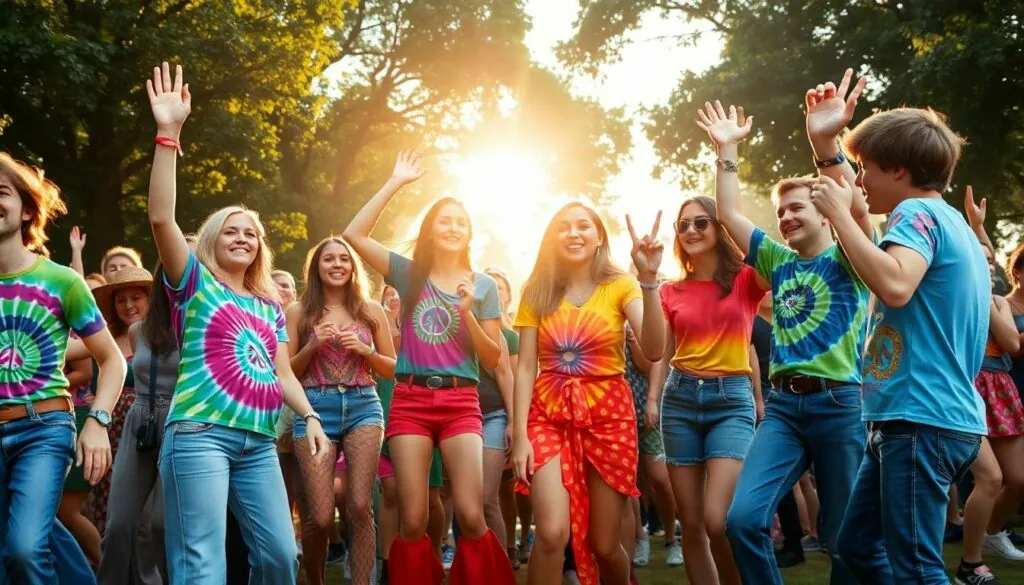The 1960s was a wild ride, a kaleidoscope of color, sound, and rebellion that forever changed the cultural landscape. From the groovy beats of Motown to the mind-bending experiments of psychedelic rock, this decade was a playground for creativity and self-expression. It was a time when bell-bottoms were a fashion statement and peace signs became a symbol of hope.
But it wasn’t just about the music and fashion. The ’60s gave birth to movements that challenged the status quo and sparked conversations about civil rights, feminism, and freedom. So grab your tie-dye shirt and get ready to dive into a decade that was anything but boring. Whether you’re a seasoned aficionado or new to the scene, the vibrant tapestry of ’60s pop culture is sure to inspire and entertain.
Table of Contents
ToggleOverview of 60s Pop Culture
The 1960s marked a pivotal decade of cultural upheaval in America and beyond. Music dominated the era, with the rise of genres such as Motown and psychedelic rock. Iconic artists like The Beatles, Bob Dylan, and Aretha Franklin shaped the soundscape, influencing generations to come.
Fashion trends flourished during this vibrant period. Youth embraced bell-bottoms, miniskirts, and tie-dye, symbolizing freedom and rebellion. Colorful accessories and peace signs became prominent, representing countercultural movements.
Social movements gained momentum, addressing critical issues such as civil rights and feminism. Activists like Martin Luther King Jr. and Gloria Steinem led transformative efforts, challenging societal norms. Sit-ins, protests, and marches characterized this period, uniting people in the pursuit of equality.
Television also played a significant role in shaping popular culture. Iconic shows like “The Ed Sullivan Show” introduced legendary bands to mass audiences. Cultural phenomena such as “Star Trek” and “The Twilight Zone” captivated viewers, exploring themes of social justice and human experience.
Artistic expression thrived through visual art and literature. Pop art emerged, with figures like Andy Warhol redefining traditional boundaries. Series of novels and poems touched on contemporary issues, resonating with young audiences hungry for change.
Youth culture flourished, with the emergence of the hippie movement advocating for peace and love. Ideals of communal living and non-violence inspired many to reject mainstream values. Through music festivals like Woodstock, communities came together to celebrate solidarity and creativity.
Musical Evolution of the 60s

The 1960s experienced remarkable musical evolution, with genres expanding and blending into new forms. Iconic artists and unforgettable songs defined the era, leaving a lasting legacy.
Influential Artists
The Beatles emerged as the most significant band, revolutionizing music and culture. Bob Dylan’s poignant lyrics captured the spirit of the times, while Aretha Franklin’s powerful voice became the anthem for the civil rights movement. The Beach Boys introduced innovative harmonies and surf rock, changing musical direction. Jimi Hendrix pushed the boundaries of electric guitar, creating a new sound. Motown artists like The Supremes and Marvin Gaye brought soulful melodies to mainstream radio, influencing countless musicians who followed.
Iconic Songs
Several songs became symbols of the decade. “I Want to Hold Your Hand” by The Beatles sparked Beatlemania across the globe. Bob Dylan’s “Blowin’ in the Wind” raised questions about peace and social justice. Aretha Franklin’s “Respect” demanded equality and empowerment, resonating with activists. “Good Vibrations” by The Beach Boys showcased musical experimentation. Jimi Hendrix’s “Purple Haze” defined psychedelic rock, leaving an indelible imprint on popular music. Each track contributed to a soundtrack that defined a generation and shaped future musical styles.
Fashion Trends in the 60s
The 1960s showcased an array of vibrant and daring fashion trends that reflected the decade’s spirit of rebellion and self-expression. Youth often embraced bold styles, highlighting individuality and breaking traditional norms.
Key Styles
Miniskirts gained popularity, serving as an emblem of freedom and empowerment for women. Bell-bottoms emerged as a staple in men’s and women’s wardrobes, characterized by their flared hems, symbolizing a new sense of casual chic. Tie-dye shirts added colorful flair, frequently seen at music festivals, where the counterculture thrived. Accessories such as chunky jewelry and bright sunglasses complemented outfits, enhancing the sense of playful creativity. The mod style, featuring sharp lines and geometric patterns, also left a lasting impression, showcasing the decade’s innovative approach to fashion.
Influential Designers
Designers like Mary Quant revolutionized the fashion landscape with her iconic designs, particularly in the realm of the miniskirt. Yves Saint Laurent introduced the tuxedo jacket for women, challenging gender norms and redefining elegance. André Courrèges popularized space-age fashion, emphasizing futuristic cuts and materials, including vinyl and plastic. Ossie Clark and Celia Birtwell infused bohemian and romantic elements into their collections, aligning with the emerging hippie movement. Together, these designers shaped the dynamic fashion scene of the 1960s, influencing styles that resonate today.
Impact of Television and Film
Television and film significantly influenced pop culture in the 1960s, shaping societal norms and trends.
Popular Shows
“Bewitched,” “The Andy Griffith Show,” and “The Dick Van Dyke Show” captured audiences with their humor and relatable characters. These series showcased family dynamics while addressing contemporary issues, allowing viewers to connect on a personal level. While “The Ed Sullivan Show” featured iconic performances from The Beatles and Elvis Presley, it helped to accelerate the British Invasion in America. “Star Trek” introduced viewers to revolutionary themes of diversity and social justice, making a lasting impact on both television and society.
Cult Classic Movies
Cult classic films from the 1960s like “Easy Rider,” “The Graduate,” and “Bonnie and Clyde” challenged traditional storytelling and cinematic conventions. “Easy Rider” explored the quest for freedom amidst counterculture movements, reflecting the evolving societal landscape. “The Graduate” used humor and drama to critique modern life and generational conflict, resonating with young audiences. “Bonnie and Clyde,” with its innovative approach to violence and romance, redefined American cinema, leading to the emergence of New Hollywood filmmaking. Each film encapsulated the spirit of the era, leaving an indelible mark on pop culture.
Social Movements Influenced by Pop Culture
Pop culture during the 1960s significantly shaped social movements, especially through music, art, and public discourse. The era saw passionate activism that responded to cultural changes.
Civil Rights Movement
The Civil Rights Movement prominently drew inspiration from influential music and prominent figures. Artists like Aretha Franklin and Sam Cooke voiced the fight for equality through powerful lyrics and memorable anthems. Martin Luther King Jr. mobilized communities via events like the March on Washington, where his “I Have a Dream” speech resonated deeply. Television coverage of protests and marches increased public awareness and support, bridging gaps among various demographic groups. Popular songs like “A Change Is Gonna Come” by Sam Cooke became rallying cries, further uniting activists. Such connections between music and activism transformed public sentiment, fostering a shared commitment to justice and equality.
Counterculture Movement
The Counterculture Movement emerged as a response to mainstream societal norms, emphasizing peace, love, and rebellion against the establishment. Hippies rejected traditional values, championing communal living and anti-war sentiments during the Vietnam War. Music festivals, particularly Woodstock, exemplified this culture, bringing together diverse individuals in celebration of freedom. Artists such as Bob Dylan and Jimi Hendrix articulated the movement’s ethos through songs that challenged authority. The rise of psychedelic art and fashion reflected this transformation, creating a distinct visual identity for the youth. This cultural shift sparked conversations about personal freedom, civil liberties, and alternative lifestyles, leaving a lasting impact on society.
The 1960s stand as a pivotal decade in shaping modern culture. Its music, fashion, and social movements not only defined an era but also laid the groundwork for future generations. The creative expressions of this time continue to resonate, inspiring artists and activists alike.
From the iconic sounds of legendary musicians to the bold fashion statements that challenged norms, the spirit of the ’60s remains alive. The cultural shifts fostered conversations around equality and freedom that still echo today.
As society reflects on this transformative period, it becomes clear that the legacy of the 1960s is woven into the fabric of contemporary culture, reminding us of the power of creativity and collective action.





